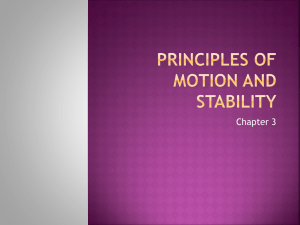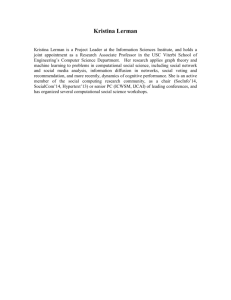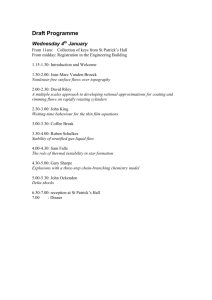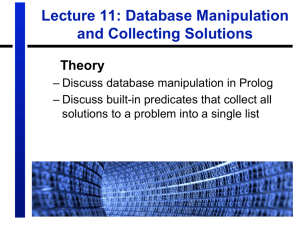X=1
advertisement
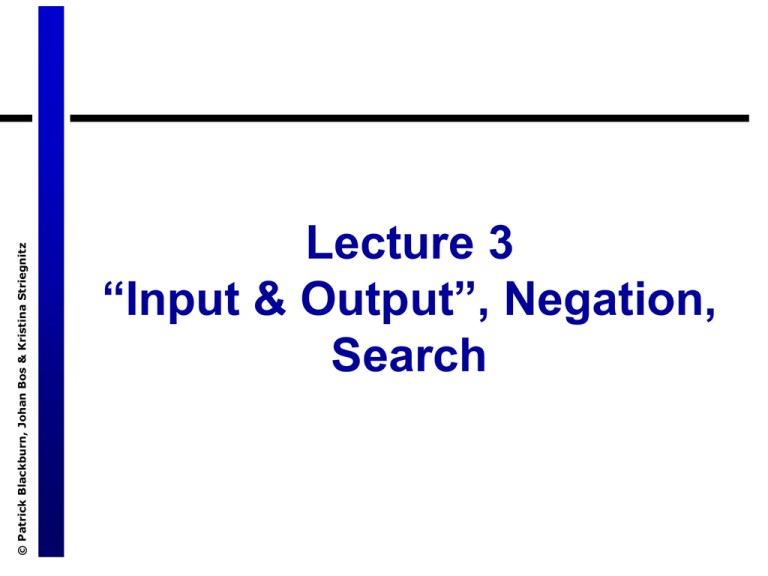
© Patrick Blackburn, Johan Bos & Kristina Striegnitz Lecture 3 “Input & Output”, Negation, Search Last Lecture © Patrick Blackburn, Johan Bos & Kristina Striegnitz • In the previous lecture we have introduced: – recursion – declarative and procedural semantics – arithmetic operators – list, head & tail of a list, recursion on lists – predicates for collecting solutions Aim of this lecture LPN Sect. 10.3 • After this lecture, you should be able to explain the following key notions and their relation to Prolog: – “input/output” in Prolog – negation as failure – search algorithms “Input and output” in Prolog Output • Predicates do not return values. Variables are instantiated through unification. This is what gives Prolog its computation power! • E.g., suppose you want to do something with the result of pairing the elements of a list with another element. Then don’t write doSomething(pair(L1,X,L2)) but: ..... :- pair(L1,X,L2), doSomething(L2, L3). • Here, L2 is taken as the “output” resulting from proving pair(L1,X,L2) Input or Output • When posing a query, often it is not fixed whether a parameter has to be “input” or “output”. Example: a2b/2 © Patrick Blackburn, Johan Bos & Kristina Striegnitz • The predicate a2b/2 takes two lists as arguments and succeeds – if the first argument is a list of as, and – the second argument is a list of bs of exactly the same length ?- a2b([a,a,a,a],[b,b,b,b]). yes ?- a2b([a,a,a,a],[b,b,b]). no ?- a2b([a,c,a,a],[b,b,b,t]). no © Patrick Blackburn, Johan Bos & Kristina Striegnitz a2b/2 a2b([],[]). a2b([a|L1],[b|L2]):- a2b(L1,L2). Both Parameters “Input” © Patrick Blackburn, Johan Bos & Kristina Striegnitz a2b([],[]). a2b([a|L1],[b|L2]):- a2b(L1,L2). ?- a2b([a,a,a],[b,b,b]). yes ?- First Parameter “Input” Second Parameter “Output” © Patrick Blackburn, Johan Bos & Kristina Striegnitz a2b([],[]). a2b([a|L1],[b|L2]):- a2b(L1,L2). ?- a2b([a,a,a,a,a], X). X = [b,b,b,b,b] yes ?- First Parameter “Output” Second Parameter “Input” © Patrick Blackburn, Johan Bos & Kristina Striegnitz a2b([],[]). a2b([a|L1],[b|L2]):- a2b(L1,L2). ?- a2b(X,[b,b,b,b,b,b,b]). X = [a,a,a,a,a,a,a] yes ?- Input or Output • Thus: When posing a query, often it is not fixed whether a parameter has to be “input” or “output”. • But: Not in all cases can any parameter be used as input or as output. Sometimes parameters have to be instantiated. Defining predicates with arithmetic © Patrick Blackburn, Johan Bos & Kristina Striegnitz addThreeAndDouble(X, Y):Y is 2 * (X+3) . f(x) = 2(x+3) Defining predicates with arithmetic © Patrick Blackburn, Johan Bos & Kristina Striegnitz addThreeAndDouble(X, Y):Y is 2 * (X+3). ?- addThreeAndDouble(1,Y). Y=8 yes ?- addThreeAndDouble(2,Y). Y=10 yes Defining predicates with arithmetic © Patrick Blackburn, Johan Bos & Kristina Striegnitz addThreeAndDouble(X, Y):Y is 2 * (X+3). ?- addThreeAndDouble(X,10). Defining predicates with arithmetic © Patrick Blackburn, Johan Bos & Kristina Striegnitz addThreeAndDouble(X, Y):Y is 2 * (X+3). ?- addThreeAndDouble(X,10). ERROR: is/2: Arguments are not sufficiently instantiated Prolog Manual • + Argument must be fully instantiated to a term that satisfies the required argument type. Think of the argument as input. • - Argument must be unbound. Think of the argument as output. • ? Argument must be bound to a partial term of the indicated type. Note that a variable is a partial term for any type. Think of the argument as either input or output or both input and output. • E.g., flatten(+List1, ?List2) © Patrick Blackburn, Johan Bos & Kristina Striegnitz Negation as Failure Negation in Logic © Patrick Blackburn, Johan Bos & Kristina Striegnitz • The assertion ¬p specifies that ¬p is true, and therefore p is false • E.g.: ¬p, ¬p → q |= q Negation in Prolog © Patrick Blackburn, Johan Bos & Kristina Striegnitz • Negation in Prolog is different from negation in logic! • In Prolog, negation is represented using the special predicate ‘not/1’ Example © Patrick Blackburn, Johan Bos & Kristina Striegnitz burger(X):- bigMac(X). burger(X):- bigKahunaBurger(X). burger(X):- whopper(X). bigMac(a). bigKahunaBurger(b). bigMac(c). whopper(d). enjoys(vincent,X) :- burger(X), not(bigKahunaBurger(X)). • not(bigKahunaBurger(X)) succeeds if bigKahunaBurger(X) cannot be derived, i.e., if bigKahunaBurger(X) fails Prolog uses “negation as failure” Example © Patrick Blackburn, Johan Bos & Kristina Striegnitz burger(X):- bigMac(X). burger(X):- bigKahunaBurger(X). burger(X):- whopper(X). bigMac(a). bigKahunaBurger(b). bigMac(c). whopper(d). enjoys(vincent,X) :- burger(X), not(bigKahunaBurger(X)). ?- enjoys(vincent,X). Example © Patrick Blackburn, Johan Bos & Kristina Striegnitz burger(X):- bigMac(X). burger(X):- bigKahunaBurger(X). burger(X):- whopper(X). bigMac(a). bigKahunaBurger(b). bigMac(c). whopper(d). enjoys(vincent,X):- burger(X), not(bigKahunaBurger(X)). ?- enjoys(vincent,X). X = a; Example © Patrick Blackburn, Johan Bos & Kristina Striegnitz burger(X):- bigMac(X). burger(X):- bigKahunaBurger(X). burger(X):- whopper(X). bigMac(a). bigKahunaBurger(b). bigMac(c). whopper(d). enjoys(vincent,X):- burger(X), not(bigKahunaBurger(X)). ?- enjoys(vincent,X). X = a; X = c; Example © Patrick Blackburn, Johan Bos & Kristina Striegnitz burger(X):- bigMac(X). burger(X):- bigKahunaBurger(X). burger(X):- whopper(X). bigMac(a). bigKahunaBurger(b). bigMac(c). whopper(d). enjoys(vincent,X):- burger(X), not(bigKahunaBurger(X)). ?- enjoys(vincent,X). X = a; X = c; X = d. © Patrick Blackburn, Johan Bos & Kristina Striegnitz Negation as failure and logic • Negation as failure is not logical negation • Changing the order of the goals in the vincent and burgers program gives a different behaviour: enjoys(vincent,X):- not(bigKahunaBurger(X)), burger(X). not(bigKahunaBurger(X)) succeeds if bigKahunaBurger(X) cannot be derived, i.e., if there are no bigKahunaBurgers. ?- enjoys(vincent,X). no Negation as failure and logic © Patrick Blackburn, Johan Bos & Kristina Striegnitz • Negation as failure is not logical negation • “not(p(X))” succeeds if p(X) cannot be derived – this is different from classical negation p, p → q |= ¬r :- dynamic(r). p. q :- p. ?- not(r). yes © Patrick Blackburn, Johan Bos & Kristina Striegnitz Negation as failure and logic • Negation as failure is not logical negation • “not” has a non-monotonic behavior: if formulas are added, it could be that it can no longer be derived p, p → q, r |= ¬r :- dynamic(r). p. r. q :- p. ?- not(r). no © Patrick Blackburn, Johan Bos & Kristina Striegnitz Negation as failure and closed world assumption (CWA) • Closed world assumption: what is not currently known to be true, is false • Example: if the train schedule does not include a train at 15:00 to A’dam, conclude that there will not be a train at 15:00 to A’dam • NAF: if we cannot derive that something is true, conclude that it is not true © Patrick Blackburn, Johan Bos & Kristina Striegnitz Search © Patrick Blackburn, Johan Bos & Kristina Striegnitz Route Planning © Patrick Blackburn, Johan Bos & Kristina Striegnitz Robot Navigation http://www.ics.forth.gr/cvrl/ Unreal Search Problems © Patrick Blackburn, Johan Bos & Kristina Striegnitz Common structure: • We are faced with an initial situation and we would like to achieve a certain goal. • At any point in time we have different simple actions available to us (e.g. “turn left” vs. “turn right”). Executing a particular sequence of such actions may or may not achieve the goal. • Search is the process of inspecting several such sequences and choosing a path that achieves the goal. Deep Blue & Watson IBM Jeopardy Computer (2011) http://mashable.com/2011/02/16/w atson-jeopardy-day-2/ IBM Chess Computer (1997) State Space and Moves © Patrick Blackburn, Johan Bos & Kristina Striegnitz Navigation in Unreal Tournament: • States are navigation points • Navigation points can be connected to other navigation points (determine moves) • Use search to determine how to get from the current navigation point to a desired one • Moving from one navigation point to the next is associated with a cost (distance); Try to reach desired navigation point at minimal cost: optimisation problem. © Patrick Blackburn, Johan Bos & Kristina Striegnitz Searching the State Space • The set of all possible sequences of legal moves form a tree • Each branch (path from root to leaf) corresponds to a sequence of states (and thereby also a sequence of moves). • Two basic ways of moving through such a tree: depth-first and breadth-first © Patrick Blackburn, Johan Bos & Kristina Striegnitz Depth-First Depth-first traversal: A→B→D→E→C→F→G Depth-First © Patrick Blackburn, Johan Bos & Kristina Striegnitz solve_depthfirst(Node, TargetNode, SolPath) :depthfirst([], Node, TargetNode, SolPath). depthfirst(Path, Node, Node, [Node|Path]). depthfirst(Path, Node, TargetNode, SolPath) :move(Node, NextNode), depthfirst([Node|Path], NextNode, TargetNode, SolPath). © Patrick Blackburn, Johan Bos & Kristina Striegnitz Breadth-First Breadth-first traversal: A→B→C→D→E→F→G © Patrick Blackburn, Johan Bos & Kristina Striegnitz Breadth-First • Store a set of candidate paths • If head of the first candidate path = target node then this path is a solution • Otherwise remove first candidate path, generate the set of all one-step extensions of this path, add this set of extensions at the end of the candidate set, and execute breadth-first search on this updated set. Summary of this Lecture • We introduced the following key notions and their relation to Prolog: – “input & output” – negation as failure – search algorithms © Patrick Blackburn, Johan Bos & Kristina Striegnitz Organization • Reading: LPN Sect. 10.3 from "Negation as failure is an impotant tool." to "The difference is crucial." • Tomorrow “werkcollege” - Assignment 2 • Next lecture (Koen Hindriks) - GOAL: introduction to agent programming
